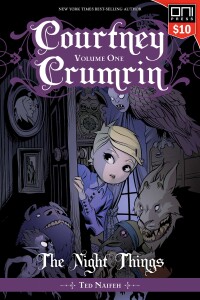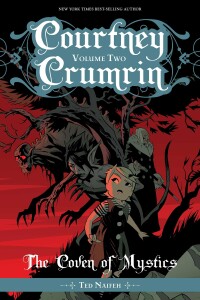 Rebecca Scott wrote this review.
Rebecca Scott wrote this review.
Let’s see:
- Plucky preteen girl? Check.
- Parents who don’t pay attention to her? Check.
- Spooky old house for them to move into? Check.
- Creepy, mean, elderly relative who lives there? Check
- Bullies at the new school? Check.
- Ghoulies and ghosties and long-leggedy-beasties and things that go bump in the night? Check.
Looks like we’ve got the full checklist for a run of the mill young adult fantasy/horror novel. Fortunately, that’s not what we’ve got.
The first thing that’s different is that Courtney Crumrin is a graphic novel series. Not that that automatically exempts it from being hackneyed, I know, but it isn’t. Because the second thing that’s different about Courtney Crumrin is Courtney. She’s cranky, rude, and misanthropic. She hates the stuck-up rich kids at school, can’t stand her parents’ aspirations, and finds she’s quite fond of her great uncle Aloysius. She takes up magic in order to get revenge. Courtney is my kind of girl.
Great Uncle Aloysius (Professor Crumrin to the people of Hillsborough) isn’t quite a standard figure, either. When he discovers Courtney out of bed past her bedtime, in the room he’s forbidden her to enter, and borrowing one of his magical tomes without permission, the first thing he says is, “That book is four hundred years old. Do be careful with it.” He doesn’t object to her getting into his books, doesn’t mind her practicing magic in the house, and doesn’t care if she casts unethical spells. He only gets upset when she does something stupid.
And then there’s Butterworm, the wolfish goblin who lives in the woods near the Crumrin house. He introduces both volumes, injects little moments of humor, and enjoys snacking on children. Butterworm is, quite possibly, the coolest character of the series.
In the opening volume, Courtney and her stupid, pretentious Yuppie parents move in with Uncle Aloysius because they were, quote, “running out of credit cards.” Repeated sightings of creepy things, a couple of encounters with bullies, and some sleepless nights give Courtney the impetus to take up witchcraft, and she finds that she’s good at it.
 In the second volume The Coven of Mystics Courtney discovers that she and her uncle are not the only sorcerers in Hillsborough. The Coven of Mystics, an assemblage of the area’s magical folk, are all stirred up. Old Rawhead and Bloody Bones is stalking the night again, and so far no witch or warlock has been able to stand against him. Aloysius believes that he was summoned out of the marl pit, but by whom? Between the cursed witch whose words turn to toads and snakes and the night thing who speaks through silence, Courtney becomes too fascinated to not investigate.
In the second volume The Coven of Mystics Courtney discovers that she and her uncle are not the only sorcerers in Hillsborough. The Coven of Mystics, an assemblage of the area’s magical folk, are all stirred up. Old Rawhead and Bloody Bones is stalking the night again, and so far no witch or warlock has been able to stand against him. Aloysius believes that he was summoned out of the marl pit, but by whom? Between the cursed witch whose words turn to toads and snakes and the night thing who speaks through silence, Courtney becomes too fascinated to not investigate.
Naifeh pulls off darkly charming fairy tales, using classic tropes in new ways. His heroine has a habit of taking a sword to the knottiest problems, and she applies the same logic to the rest of her life, in ways most of us wished we could do at that age.
Many of the fears of the teenage years are addressed here: fitting in, or not wanting to; feelings of inadequacy; responsibilities; the injustice of the world. Courtney is appropriately and refreshingly self-centered about it all, without being selfish.
The art, all in black-on-white pen-and-ink work, is dark, twisty, and enchanting. Obviously anime-influenced, the children all tend towards the big-eyes-small-mouth template. It’s a style I’ve never cared for, but Naifeh makes it work here, allowing it to lend an appropriately half finished look to the younger generation. Courtney and her peers become iconic, adding to the fairy-tale atmosphere. Adults have craggier, more proportional, yet sketchy feature; fitting, since children rarely pay that much attention to grown-ups. Backgrounds tend to be detailed without detracting from the figures, with lots of dark shadows drawn in with well-applied crosshatching (a style I do like). Proportions and perspectives are all warped, giving that smaller-than-scale feeling of childhood. Over all, this slavishly gothic style tends to grab you and pull you in.
The quality of art is hardly surprising; Naifeh is a veteran indie comic book artist. What’s new for him with The Night Things is the writing. Pacing and plotting are crisp and well-timed (and both are harder to do in a comic book than one might think), but the dialogue and narrative are where he shows his lack of experience. They run to the slightly awkward, especially the incantations, which lack the music implied by the word. It’s not too egregious, though. Some of my favorite authors had considerably worse writing in their first books.
He improves considerably in The Coven of Mystics. Dialogue flows more smoothly, the narrative blocks are less distracting, and the incantations have the approved Elizabethan doggerel form. I particularly like Courtney’s poem in chapter four. It is, indeed, the epitome of (well done) thirteen-year-old girl poetry.
One minor quibble I have with both volumes is that while Butterworm introduces and closes each storyline, the narrative inside the stories is not his. I can see how it could become inconvenient to use his very distinctive voice, but occasionally the narrative voice that is used gets very personal about the story, leaving me wondering who exactly is telling this tale.
I’m very picky when it comes to fiction based on myths and fairy tales: I like them to actually be based on what they claim to be based on, to stay true to those traditions. Books that do this can sometimes be very hard to find. Courtney Crumrin does very well at staying true to the folklore indeed. Where Naifeh borrows, he portrays well and faithfully; where he invents, he does so consistently and creatively. It isn’t creatures he changes but settings, modernizing his ghouls and faeries by context, not content.
There’s an awful lot of good fantasy out these days for the younger set. A good-sized subset of this is also enjoyable by well-read adults. Courtney Crumrin is one of the few comics that falls into this set, though, and it’s one of the best.
I’m very much looking forward to the release of the next volume, The Twilight Kingdom, due out in September. I may even have to see if I can’t track down the four issues that will be collected in it. I’m not sure I can wait!
(Oni Press, 2002)
(Oni Press, 2003)
